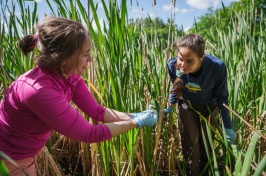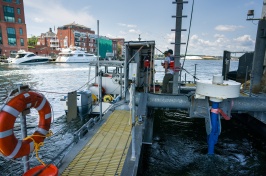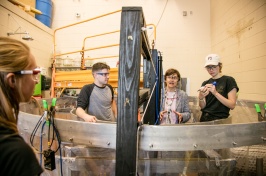UNH Researchers Find Reforestation May Play a Role in New England Climate
DURHAM, N.H. - The winter months in New England this past year were considered mild, by meteorological standards. While some experts look to global warming for answers, researchers at the University of New Hampshire have found that, in the New England area, reforestation may also hold some clues to climate in wintertime.
The study, conducted by Elizabeth Burakowski, a postdoctoral research associate at UNH and visiting scientist at the National Center for Atmospheric Research, was released early online and will be published in an upcoming issue of the Journal of Climate. The study can be reviewed at: http://journals.ametsoc.org/doi/abs/10.1175/JCLI-D-15-0286.1?af=R&
Burakowski and her team found that when a landscape is reforested, it changes the way energy is exchanged between the surface and the atmosphere. Their work focused on the decrease in albedo, or surface reflectivity, when a field returns to a forest. Forests absorb more of the sun's energy than do pastures or croplands and that energy gets converted into heat, therefore warming up the surface.
"It is similar to the reflective qualities of clothing," said Burakowski. "Just like choosing to wear a white shirt in the summer, the white snow will reflect the sun and therefore make it cooler. But a dark shirt, similar to a dense forest, will absorb the sun's energy, leading to warming."
History shows that when European settlers came to the New England region of the United States in the 1800's, many forested areas were cleared for agriculture and pasture. To draw comparisons between the forestation of the land then and now, the study set out to investigate climate impacts of reforestation in the wintertime (December through March) in New England using a high-resolution, multi-physics ensemble of the Weather Research and Forecasting model.
"Our modeling experiments indicate that the present-day reforested New England landscape is probably warmer than the deforested pastures and croplands in the mid-1800s due to that change in albedo," said Burakowski.
Researchers found that warmer conditions over forests were primarily the result of increased absorbed shortwave radiation and increased sensible heat flux compared to cropland/grassland. The albedo of a surface can influence local and regional climate by either reflecting sunlight to create a cooling effect or absorbing it to warm surfaces and surrounding air. Weaker warming happened during warm, dry winters compared to an increase in overall warming in cold, snowy winters.
The researchers say that it is important to note that this study focused on albedo and that other surface properties related to land cover can also affect surface climate such as how much water is moved from the vegetation to the atmosphere and how rough a canopy is, which can affect the redistribution of energy at the surface. While reforestation is a likely contributor to historical warming trends in the New England region, the researchers say more studies are needed to determine how much of the warming from that time to the present is due to land cover change and how much is due to other factors like greenhouse gas emissions and natural climate change.
The University of New Hampshire, founded in 1866, is a world-class public research university with the feel of a New England liberal arts college. A land, sea, and space-grant university, UNH is the state's flagship public institution, enrolling 13,000 undergraduate and 2,500 graduate students.
Elizabeth Burakowski can be reached at (303) 497-1771 and burakows@ucar.edu
Latest News
-
October 30, 2024
-
October 10, 2024
-
October 8, 2024
-
October 3, 2024
-
October 1, 2024
















































